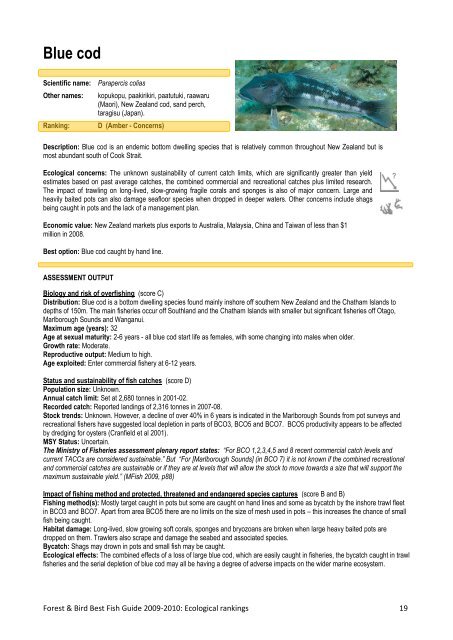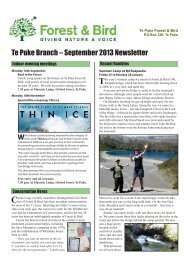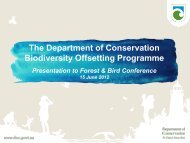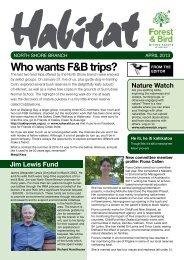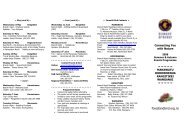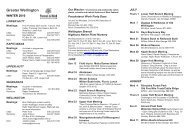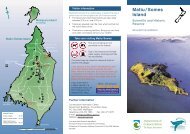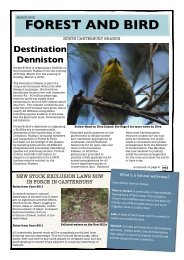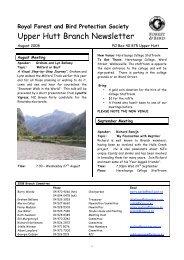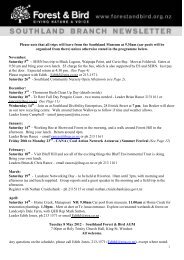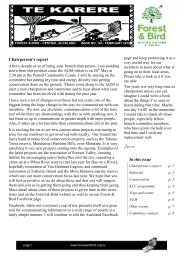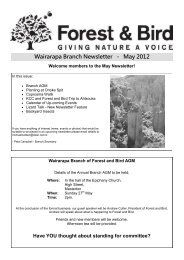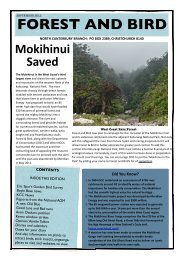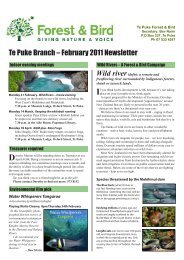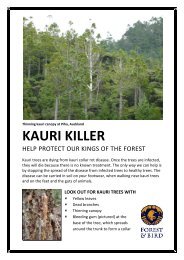Best Fish Guide 2009-2010 - Forest and Bird
Best Fish Guide 2009-2010 - Forest and Bird
Best Fish Guide 2009-2010 - Forest and Bird
Create successful ePaper yourself
Turn your PDF publications into a flip-book with our unique Google optimized e-Paper software.
Blue cod<br />
Scientific name: Parapercis colias<br />
Other names: kopukopu, paakirikiri, paatutuki, raawaru<br />
(Maori), New Zeal<strong>and</strong> cod, s<strong>and</strong> perch,<br />
taragisu (Japan).<br />
Ranking: D (Amber - Concerns)<br />
Description: Blue cod is an endemic bottom dwelling species that is relatively common throughout New Zeal<strong>and</strong> but is<br />
most abundant south of Cook Strait.<br />
Ecological concerns: The unknown sustainability of current catch limits, which are significantly greater than yield<br />
estimates based on past average catches, the combined commercial <strong>and</strong> recreational catches plus limited research.<br />
The impact of trawling on long-lived, slow-growing fragile corals <strong>and</strong> sponges is also of major concern. Large <strong>and</strong><br />
heavily baited pots can also damage seafloor species when dropped in deeper waters. Other concerns include shags<br />
being caught in pots <strong>and</strong> the lack of a management plan.<br />
Economic value: New Zeal<strong>and</strong> markets plus exports to Australia, Malaysia, China <strong>and</strong> Taiwan of less than $1<br />
million in 2008.<br />
<strong>Best</strong> option: Blue cod caught by h<strong>and</strong> line.<br />
ASSESSMENT OUTPUT<br />
Biology <strong>and</strong> risk of overfishing (score C)<br />
Distribution: Blue cod is a bottom dwelling species found mainly inshore off southern New Zeal<strong>and</strong> <strong>and</strong> the Chatham Isl<strong>and</strong>s to<br />
depths of 150m. The main fisheries occur off Southl<strong>and</strong> <strong>and</strong> the Chatham Isl<strong>and</strong>s with smaller but significant fisheries off Otago,<br />
Marlborough Sounds <strong>and</strong> Wanganui.<br />
Maximum age (years): 32<br />
Age at sexual maturity: 2-6 years - all blue cod start life as females, with some changing into males when older.<br />
Growth rate: Moderate.<br />
Reproductive output: Medium to high.<br />
Age exploited: Enter commercial fishery at 6-12 years.<br />
Status <strong>and</strong> sustainability of fish catches (score D)<br />
Population size: Unknown.<br />
Annual catch limit: Set at 2,680 tonnes in 2001-02.<br />
Recorded catch: Reported l<strong>and</strong>ings of 2,316 tonnes in 2007-08.<br />
Stock trends: Unknown. However, a decline of over 40% in 6 years is indicated in the Marlborough Sounds from pot surveys <strong>and</strong><br />
recreational fishers have suggested local depletion in parts of BCO3, BCO5 <strong>and</strong> BCO7. BCO5 productivity appears to be affected<br />
by dredging for oysters (Cranfield et al 2001).<br />
MSY Status: Uncertain.<br />
The Ministry of <strong>Fish</strong>eries assessment plenary report states: “For BCO 1,2,3,4,5 <strong>and</strong> 8 recent commercial catch levels <strong>and</strong><br />
current TACCs are considered sustainable.” But “For [Marlborough Sounds] (in BCO 7) it is not known if the combined recreational<br />
<strong>and</strong> commercial catches are sustainable or if they are at levels that will allow the stock to move towards a size that will support the<br />
maximum sustainable yield.” (M<strong>Fish</strong> <strong>2009</strong>, p88)<br />
Impact of fishing method <strong>and</strong> protected, threatened <strong>and</strong> endangered species captures (score B <strong>and</strong> B)<br />
<strong>Fish</strong>ing method(s): Mostly target caught in pots but some are caught on h<strong>and</strong> lines <strong>and</strong> some as bycatch by the inshore trawl fleet<br />
in BCO3 <strong>and</strong> BCO7. Apart from area BCO5 there are no limits on the size of mesh used in pots – this increases the chance of small<br />
fish being caught.<br />
Habitat damage: Long-lived, slow growing soft corals, sponges <strong>and</strong> bryozoans are broken when large heavy baited pots are<br />
dropped on them. Trawlers also scrape <strong>and</strong> damage the seabed <strong>and</strong> associated species.<br />
Bycatch: Shags may drown in pots <strong>and</strong> small fish may be caught.<br />
Ecological effects: The combined effects of a loss of large blue cod, which are easily caught in fisheries, the bycatch caught in trawl<br />
fisheries <strong>and</strong> the serial depletion of blue cod may all be having a degree of adverse impacts on the wider marine ecosystem.<br />
<strong>Forest</strong> & <strong>Bird</strong> <strong>Best</strong> <strong>Fish</strong> <strong>Guide</strong> <strong>2009</strong>-<strong>2010</strong>: Ecological rankings 19<br />
?


